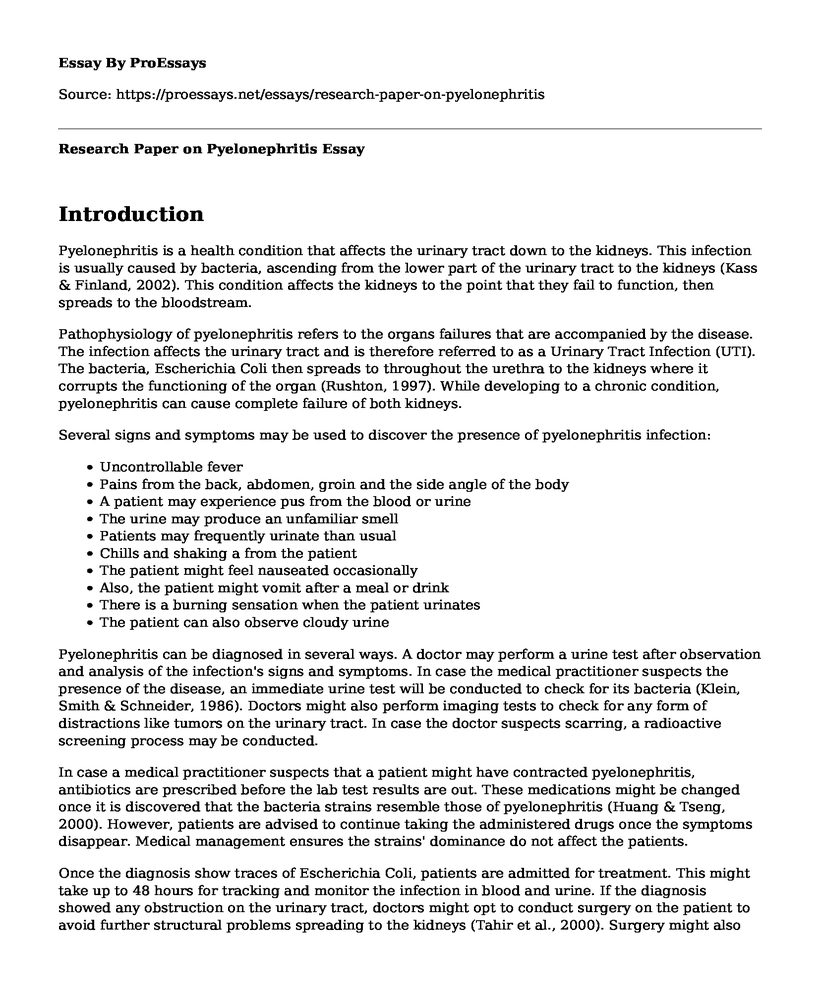Introduction
Pyelonephritis is a health condition that affects the urinary tract down to the kidneys. This infection is usually caused by bacteria, ascending from the lower part of the urinary tract to the kidneys (Kass & Finland, 2002). This condition affects the kidneys to the point that they fail to function, then spreads to the bloodstream.
Pathophysiology of pyelonephritis refers to the organs failures that are accompanied by the disease. The infection affects the urinary tract and is therefore referred to as a Urinary Tract Infection (UTI). The bacteria, Escherichia Coli then spreads to throughout the urethra to the kidneys where it corrupts the functioning of the organ (Rushton, 1997). While developing to a chronic condition, pyelonephritis can cause complete failure of both kidneys.
Several signs and symptoms may be used to discover the presence of pyelonephritis infection:
- Uncontrollable fever
- Pains from the back, abdomen, groin and the side angle of the body
- A patient may experience pus from the blood or urine
- The urine may produce an unfamiliar smell
- Patients may frequently urinate than usual
- Chills and shaking a from the patient
- The patient might feel nauseated occasionally
- Also, the patient might vomit after a meal or drink
- There is a burning sensation when the patient urinates
- The patient can also observe cloudy urine
Pyelonephritis can be diagnosed in several ways. A doctor may perform a urine test after observation and analysis of the infection's signs and symptoms. In case the medical practitioner suspects the presence of the disease, an immediate urine test will be conducted to check for its bacteria (Klein, Smith & Schneider, 1986). Doctors might also perform imaging tests to check for any form of distractions like tumors on the urinary tract. In case the doctor suspects scarring, a radioactive screening process may be conducted.
In case a medical practitioner suspects that a patient might have contracted pyelonephritis, antibiotics are prescribed before the lab test results are out. These medications might be changed once it is discovered that the bacteria strains resemble those of pyelonephritis (Huang & Tseng, 2000). However, patients are advised to continue taking the administered drugs once the symptoms disappear. Medical management ensures the strains' dominance do not affect the patients.
Once the diagnosis show traces of Escherichia Coli, patients are admitted for treatment. This might take up to 48 hours for tracking and monitor the infection in blood and urine. If the diagnosis showed any obstruction on the urinary tract, doctors might opt to conduct surgery on the patient to avoid further structural problems spreading to the kidneys (Tahir et al., 2000). Surgery might also be performed when antibiotics don't seem to be efficient.
Nursing intervention for pyelonephritis involves a regular check up on the patient's body temperature. If the change is too significant, the body functioning has changed. A recording of the urine's characteristics should help identify the progress of the condition (Gray, 2004). The patient has to take a lot of water to avoid urine stasis. Nurses should identify the body parts that express pain which indicates signs of an infection. Administration of analgesics reduces the pain that patients feel.
Patients are advised to finish up all prescribed medications since a halt might cause regeneration of the infection. Water should frequently be taken since the fluid flushes infections from the track. Cleanliness of the genital areas should be maintained. Frequent urination helps to wipe the infection from the system. The advised checkups should be followed for monitoring purposes. In case the signs and symptoms are back, call the doctor for instructions.
References
Gray, M. (2004). What nursing interventions reduce the risk of symptomatic urinary tract infection in the patient with an indwelling catheter?. Journal of Wound Ostomy & Continence Nursing, 31(1), 3-13.
Huang, J. J., & Tseng, C. C. (2000). Emphysematous pyelonephritis: clinicoradiological classification, management, prognosis, and pathogenesis. Archives of Internal Medicine, 160(6), 797-805.
Kass, E. H., & Finland, M. (2002). Asymptomatic infections of the urinary tract. The Journal of urology, 168(2), 420-424.
Klein, F. A., Smith, M. J., & Schneider, V. (1986). Emphysematous pyelonephritis: diagnosis and treatment. Southern medical journal, 79(1), 41-46.
Rushton, H. G. (1997). The evaluation of acute pyelonephritis and renal scarring with technetium 99m-dimercaptosuccinic acid renal scintigraphy: evolving concepts and future directions. Pediatric Nephrology, 11(1), 108-120.
Tahir, H., Thomas, G., Sheerin, N., Bettington, H., Pattison, J. M., & Goldsmith, D. J. (2000). Successful medical treatment of acute bilateral emphysematous pyelonephritis. American journal of kidney diseases, 36(6), 1267-1270.
Cite this page
Research Paper on Pyelonephritis. (2022, Jun 19). Retrieved from https://proessays.net/essays/research-paper-on-pyelonephritis
If you are the original author of this essay and no longer wish to have it published on the ProEssays website, please click below to request its removal:
- Essay on Nursing: Supporting a Safe Environment
- Intercultural Learning, Global Health, and Nursing: Teaching and Learning Strategies
- Hazard Prevention Through Effective Safety and Health Training Paper Example
- Essay Sample on Nurses in New Jersey: Quality Healthcare Services for the Public
- Essay on Info Tech Transforms Healthcare: Enhancing Training for Nurses & Med Pros
- Essay Example on Curriculum Dev. & Challenges in Nursing Ed: Examining Trends & Issues
- Essay Example on Medical Negligence: Nonfeasance, Malfeasance, and Misfeasance Explained







